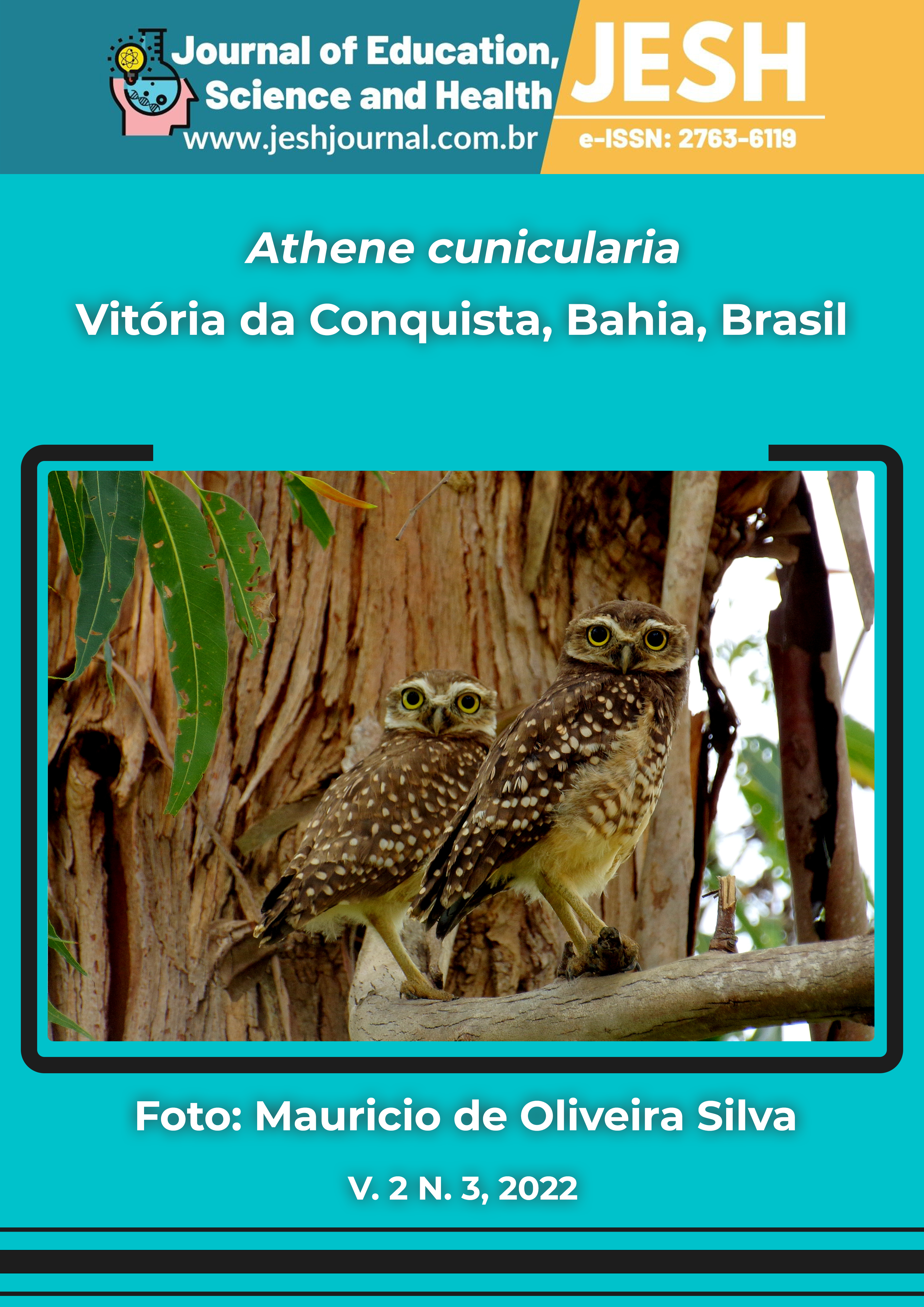Cogumelos do Brasil e a Ciência Cidadã na divulgação da funga brasileira
DOI:
10.52832/jesh.v2i3.142Resumo
A ciência cidadã corresponde à incorporação do conhecimento de pessoas não envolvidas diretamente com o ambiente acadêmico na produção do conhecimento científico. O monitoramento da biodiversidade é um dos tipos de projeto que se beneficia com a participação da ciência cidadã, já que os centros de pesquisa muitas vezes não possuem recursos suficientes para coletar informações relevantes sobre as espécies locais. No levantamento da diversidade de macrofungos, os projetos de ciência cidadã são essenciais, pois estamos nos referindo a estruturas reprodutivas efêmeras, sazonais e muitas vezes com distribuição restrita. Neste trabalho apresentamos dados referentes ao Grupo Cogumelos do Brasil, uma comunidade virtual na rede social Facebook que existe desde 2013. Entre maio e junho de 2021 foi realizado um levantamento de espécies baseado em fotografias postadas no grupo. Após o mês de acompanhamento, verificamos que 61 membros, oriundos de 17 estados brasileiros, publicaram fotografias de pelo menos 126 táxons diferentes de macrofungos (ascomicetos e basidiomicetos). Ainda, são apresentados estudos de caso que demonstram o potencial deste grupo para futuros estudos envolvendo ciência cidadã.

Downloads
Métricas
Referências
Arazy, O., & Malkinson, D. (2021). A framework of observer-based biases in citizen science biodiversity monitoring: semi-structuring unstructured biodiversity monitoring protocols. Frontiers in Ecology and Evolution, 9, article 693602. https://doi.org/10.3389/fevo.2021.693602 DOI: https://doi.org/10.3389/fevo.2021.693602
Bas, C. (1969). Morphology and subdivision of Amanita and a monograph on its section Lepidella. Persoonia, 5(4), 285–579.
Bas, C. (1978). Studies in Amanita. I. Some Amazonian species. Persoonia, 10(1), 1–22.
Brazilian Flora Group – BFG (2022). Brazilian Flora 2020: leveraging the power of a collaborative scientific network. Taxon, 71(1), 178–198. https://doi.org/10.1002/tax.12640 DOI: https://doi.org/10.1002/tax.12640
Campi, M., Maubet, Y., & Trierveiler-Pereira, L. (2021). Rediscovery of Clathrus argentinus and new contributions to the gasteroid mycobiota of Paraguay. Current Research in Environmental & Applied Mycology, 11(1), 90–111. https://doi.org/10.5943/cream/11/1/8 DOI: https://doi.org/10.5943/cream/11/1/8
Cartwright, J. (2016). Technology: Smartphone science. Nature, 531, 669–671. https://doi.org/10.1038/nj7596-669a DOI: https://doi.org/10.1038/nj7596-669a
Dring, D. M. (1980). Contributions towards a rational arrangement of the Clathraceae. Kew Bulletin, 35, 1–96. DOI: https://doi.org/10.2307/4117008
Ediriweera, A. N., Karunarathna, S. C.; Xu, J., Hyde, K. D., & Mortimer, P. E. (2017). Entoloma mengsongense sp. nov. (Entolomataceae, Agaricales), a remarkable blue mushroom from Yunnan Province, China. Turkish Journal of Botany, 41, 505–515. https://doi.org/10.3906/bot-1611-13 DOI: https://doi.org/10.3906/bot-1611-13
Fazolino, E. P., Trierveiler-Pereira, L., Calonge, F. D., & Baseia, I. G. (2010). First records of Clathrus (Phallaceae, Agaricomycetes) from the Northeast Region of Brazil. Mycotaxon, 113, 195–202. DOI: https://doi.org/10.5248/113.195
Flora do Brasil (2020) Agaricales. Flora do Brasil 2020, Jardim Botânico do Rio de Janeiro. http://floradobrasil.jbrj.gov.br/reflora/floradobrasil/FB12
Gura, T. (2013). Citizen science: Amateur experts. Nature, 496, 259–261. https://doi.org/10.1038/nj7444-259a DOI: https://doi.org/10.1038/nj7444-259a
Guzmán, G. (2003). Los hongos de El Edén, Quintana Roo. Introducción a la micobiota tropical de México. Xalapa: Instituto de Ecología. DOI: https://doi.org/10.1590/S0036-46652004000500017
Karstedt, F., & Capelari, M. (2013). Inocephalus (Entolomataceae, Agaricales) from São Paulo State, Brazil. Nova Hedwigia, 96, 279–308. https://doi.org/10.1127/0029-5035/2012/0055 DOI: https://doi.org/10.1127/0029-5035/2012/0055
Meijer, A. A. R. (2006). Preliminary list of the macromycetes from the Brazilian State of Paraná. Boletim do Museu Botânico Municipal, Curitiba, 68, 1–55.
Menolli Jr., N., Capelari, M., & Baseia, I. G. (2009). Amanita viscidolutea, a new species from Brazil with a key to Central and South American species of Amanita section Amanita. Mycologia, 101(3), 395–400. https://doi.org/10.3852/07-079 DOI: https://doi.org/10.3852/07-079
Michelot, D. & Melendez-Howell, L. M. (2003). Amanita muscaria: chemistry, biology, toxicology, and ethnomycology. Mycological Research, 107(2), 131–146. DOI: https://doi.org/10.1017/S0953756203007305
Neves, M. A., & Furtado, A. (2020). The IUCN Red List of Threatened Species 2020: Amanita viscidolutea. https://dx.doi.org/10.2305/IUCN.UK.2020-3.RLTS.T172740193A172861167.en. DOI: https://doi.org/10.2305/IUCN.UK.2020-3.RLTS.T172740193A172861167.en
Pocock, M. J. O, Chandler, M., Bonney, R., Thornhill, I., Albink, A., August, T., Bachman, S., Brown, P. M. J., Cunha, D. G. F., Grez, A., Jackson, C., Peters, M., Rabarijaonkk, N. R., Roy, H. E., Zaviero, T., & Danielsen, F. (2018). A vision for global biodiversity monitoring with citizen science. Advances in Ecological Research, 59, 169–223. https://doi.org/10.1016/bs.aecr.2018.06.003 DOI: https://doi.org/10.1016/bs.aecr.2018.06.003
Rick, J. (1931). Monographia Pezizinearum Riograndensium. Brotéria, Série Botânica, 25, 77–98.
Saccardo, P. A. (1887). Sylloge fungorum omnium hucusque cognitorum, Vol. 5. Agaricineae. Pádua: Typis Seminarii.
Scheibler, G. (2019). Sistemática de Amanita Pers. (Amanitaceae, Basidiomycota) no Brasil. (Dissertação de Mestrado, Programa de Pós-Graduação em Biologia de Fungos, Algas e Plantas, Universidade Federal de Santa Catarina)
https://repositorio.ufsc.br/bitstream/handle/123456789/215338/PBFA0052-D.pdf?sequence=-1
Sistema de Informação sobre a Biodiversidade Brasileira – SiBBr (2022). Ciência Cidadã: o que é Ciência Cidadã? https://sibbr.gov.br/cienciacidada/oquee.html?lang=pt_BR
Shirk, J. L., Ballard, H. L., Wilderman, C. C., Phillips, T., Wiggins, A., Jordan, R., McCallie, E., Minarchek, M., Lewenstein, B.V., Krasny, M. E., & Bonney, R. (2012). Public participation in scientific research: a framework for deliberate design. Ecology and Society, 17(2), article 29. http://dx.doi.org/10.5751/ES-04705-170229 DOI: https://doi.org/10.5751/ES-04705-170229
Strasser, B. J., Baudry, J., Mahr, D., Sanchez, G., & Tancoigne, E. (2019). “Citizen Science”? Rethinking science and public participation. Science & Technology Studies, 2(2), 52–76. https://doi.org/10.23987/sts.60425 DOI: https://doi.org/10.23987/sts.60425
Sydow, H., & Sydow, P. (1907). Verzeichnis der von Herrn F. Noack in Brasilien gesammelten Pilze. Annales Mycologici, 5(4), 348–363.
Trierveiler-Pereira, L. (2015). Phalloid fungi (Phallales) of Brazil. Field Guides, The Field Museum, n. 716.
https://fieldguides.fieldmuseum.org/guides/guide/716
Trierveiler-Pereira, L. (2022). Clathrus. Flora do Brasil 2020, Jardim Botânico do Rio de Janeiro. http://floradobrasil.jbrj.gov.br/reflora/floradobrasil/FB92655
Trierveiler-Pereira, L., Baltazar, J. M., Loguercio-Leite, C. (2008). Notes on Chlorociboria (Helotiales, Ascomycota) in Southern Brazil. Mycotaxon, 104, 415–421.
Viana, B., & Queiroz, C. (2020). Ciência cidadã para além da coleta de dados.
https://www.comciencia.br/ciencia-cidada-para-alem-da-coleta-de-dados
Downloads
Publicado
Como Citar
Edição
Seção
Licença
Copyright (c) 2022 Journal of Education Science and Health

Este trabalho está licenciado sob uma licença Creative Commons Attribution-NonCommercial 4.0 International License.

































